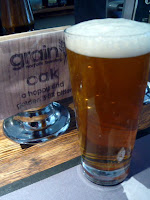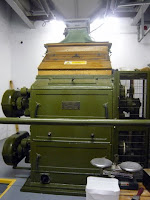 Schiehallion (Cask, 4.8% abv)
Schiehallion (Cask, 4.8% abv)This obscenely quaffable ale-style lager, named after a Scottish mountain pronounced "she-hal-i-on", has become a summer mainstay at The Gunmakers in Clerkenwell. Described by brewer Harviestoun as a "cask-conditioned lager beer", it's made with lager malt and lager hops, but is treated in every other way - and tastes like - an ale, with no carbonation. The appearance is golden-orange (pictured top), the aroma, fresh hops, and the mouthfeel creamy. On a previous tasting I claimed it was so pleasant I could happily drink nine pints of the stuff (maybe next summer). Warning: I can't vouch for the bottled version.
Elderado (Cask, 3.5%)
A pleasant offering from Bowman, the Hampshire brewery. Made, apparently, with real elderflowers, the taste hinted at its ingredient without overdoing it. Refreshing.
 Lakeland Blonde (Bottle, 4.2%)
Lakeland Blonde (Bottle, 4.2%)Another example of a lagery ale, or an aley lager, Lakeland Blonde is produced in Cockermouth by the Bitter End Brewing Co, who describe their produce as "beer without compromise". Brewed with lager barley and "pure Cumbrian water" (is there any other kind?), this golden beer was smooth but flavourful and moreish, with a long, sweetish honey finish. The 500ml bottle provided quite a chunky serving, and a decent amount of bubbles. As I say, it struck me as one of those ale/lager hybrids, like the Schiehallion, or Fuller's Honeydew, taking the best of both genres. As Bitter End notes, helpfully, Lakeland is "not to be confused with bland tasteless mass produced beers". Also available casked.
 Oak (Cask, 3.8%)
Oak (Cask, 3.8%)From the Grain Brewery, in Norfolk, comes a series of interesting beers. Of the near-dozen available, I found the Oak on tap at a pub, and it was indeed the "well-balanced session beer" promised. Awarded 1st place Bitter in the 2008 CAMRA Norwich Beer Festival - and you can't say that about every beer.
Lord Marples (Cask, 4.0%)
Thornbridge is one of those brewers in which ale fans are meant to be well-versed. I confess, I'd never tried one before this half of Lord Marples, their "classic British bitter". I ordered it on my first visit to the Cask Pub and Kitchen, in London's Pimlico, which instantly vaulted into my top ten list of favourite pubs (check out the 30-page beer menu!). As for the Marples, I decided I wanted something a tad homely after a glass of BrewDog's dry & bitter Physics, and the Marples's "light toffee and caramel characteristics" were just the antidote. I will be back for more from this Derbyshire brewer.
Paradox Isle of Arran (Cask, 10%)
While we're on BrewDog, a quick note about its Paradox series (which involves adding its Imperial Stout to various ex-whisky barrels for a time). Having enjoyed the Smokehead and the Springbank, I'd been keen to complete the set by tasting the Isle of Arran expression too. Fortunately (obviously?), the Cask pub had it on tap. It was excellent, almost preferable to the Smokehead, with the Arran's vanilla-sweetness providing a delicious counterweight to the usual bitter-black viscosity.
Thornbridge is one of those brewers in which ale fans are meant to be well-versed. I confess, I'd never tried one before this half of Lord Marples, their "classic British bitter". I ordered it on my first visit to the Cask Pub and Kitchen, in London's Pimlico, which instantly vaulted into my top ten list of favourite pubs (check out the 30-page beer menu!). As for the Marples, I decided I wanted something a tad homely after a glass of BrewDog's dry & bitter Physics, and the Marples's "light toffee and caramel characteristics" were just the antidote. I will be back for more from this Derbyshire brewer.
Paradox Isle of Arran (Cask, 10%)
While we're on BrewDog, a quick note about its Paradox series (which involves adding its Imperial Stout to various ex-whisky barrels for a time). Having enjoyed the Smokehead and the Springbank, I'd been keen to complete the set by tasting the Isle of Arran expression too. Fortunately (obviously?), the Cask pub had it on tap. It was excellent, almost preferable to the Smokehead, with the Arran's vanilla-sweetness providing a delicious counterweight to the usual bitter-black viscosity.





























